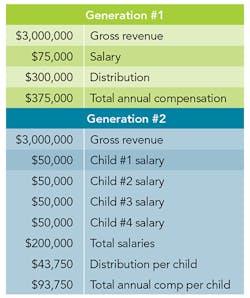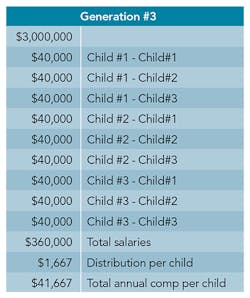Latest from Best Practices
Sponsored
Too many mouths to feed in 2nd generation family businesses
The challenges in multi-generational family businesses are well-known. The statistics bear out the number of failures when transferred from Generation #1 to Generation #2. So, how can we break this cycle? This article talks about “Best Practices” and provides some key areas for business owners to consider when looking ahead to plan their exit.
I love small business owners. They epitomize the American dream and the cowboy spirit. They “went west” with nothing more than what their horses and wagons could carry. They started small businesses with less than $5,000, and they have built them into $1.5 to $4 million dollar annual revenue businesses. However, there is a crucial problem that happens when these business founders turn over their businesses to the next generation.
The problem is, that which provided a perfectly comfortable (or even extraordinary) lifestyle for a single family cannot do the same for four grown children with families. Let’s look at the math. For purposes of our example, we’ll use a $3 million dollar business with 30 employees. We’ll assume that Dad takes a $75,000 salary and then takes home a 10% distribution.
Even if we back off the annual salaries to $50,000 instead of $75,000, you quickly see how fast the money goes. You can first argue that $93,750/year is a great income, and you would be correct. However, when you compare it to what “Dad” was bringing home before, their lifestyles are nowhere near as nice as “Dad’s” was.
The spiral continues downward from here. Let’s take it out one more generation, and assume that just three of the kids have three kids of their own:
Now each annual income is below the average median income in the US. The kids could likely do better financially to go work elsewhere than to join the family business. What do we do about this?
There are really only three options:
1. Dad has to decide how to structure the business to pass on his legacy. This can create all manner of infighting among the kids. Which child will “run” the business and receive the monthly cash flow? Will all the kids “share” in the equity that resides in the land and building? Since that is not readily accessible, does that mean that if Son #1 takes over the business, he immediately has to do one of two things?
a. Sell the land and building and move the business to a new location so that he can pay off his siblings
b. Take out a loan to “buy out” the siblings of their part of the estate, and then he pays himself back through cash flow of the business
2. Dad can simply ignore the problem, fail to provide a comprehensive will and let the kids sort out the mess after him and mom pass on. This is incredibly irresponsible of Dad, and yet we see this type of thing happen every day. Worse yet, Dad dies before Mom, and Mom simply inherits everything (such as in Texas where estates are community property). Now Mom, who was never really involved in the business decisions, but is reliant on the cash flow, has to be the arbiter between her children on who should get what. If Mom fails to put all the proper legal documents in place, then the kids have to go through Probate to work it all out. In Texas, if everything is in order, you can be through with this entire process in less than six months, and the cost can be $3,000 or less. However, if the documents are not up-to-date and in order, then you can spend a year or more. If a will is contested, it can stretch out the litigation to several years. A famous case was Anna Nicole Smith’s contest of Howard Marshall’s $1.6 billion will. He died in 1995 and supposedly left everything to his stepson. Anna Nicole Smith and her son were both left out of the will, and they battled it until her death. As of a couple years ago, the US Circuit Court had still not made a final ruling on the case, some 18 years later…
3. Dad can set the business on a path for growth, that way it can grow both top line revenue and bottom line net profit, thereby providing an excellent living for all the kids and grandkids. Unfortunately, this is easier said than done.
See, Dad built the business around something that he was very good at. Some technical skill, be it a mechanic, plumber, A/C technician, or other. However, he is not good at “managing and leading people.” Most small business owners would be fired if they took a corporate job. They don’t have the requisite ability to shut their mouth and take orders, they don’t have the ability to play politics, and they are likely not that good at being part of a team. Hence the reason they went into business for themselves. The question becomes, how does a Chief Technical Officer change his attitude and behavior in order to recruit, motivate, inspire, and lead a group of people to do (hopefully) a better job at his technical skill than he ever did?
The first challenge is mental because Dad’s ego says that he is the “best (insert technical skill here)” that he knows. That may be true. However, it doesn’t always have to be true. Dad could choose to hire young talent, someone humble, hungry, and highly motivated, and teach them how to become a great plumber, for example. In addition to teaching him that crucial technical skill, he could ensure that he grows into a successful business executive, by having him take business courses at the local community college, a management training program, and other outside learning opportunities. Perhaps most importantly, have him read a number of leadership and business books and then be prepared to discuss them. Dad’s first and foremost goal has to be, that his young mentee becomes more successful than he ever was.
The other option for Dad is to build a Senior Management Team of folks that complement each other’s skill sets. Get a Master Plumber, an Excellent Executive Coach, a Financial Whiz, an IT expert, and a Rockstar Sales individual, and you are well on your way to creating a winning team. If you can get each of those individuals to see the vision of building this company to a $5 million, $10 million, $20 million company, then you can unleash their creative talents, and they can drive the bus. Recall Jim Collins’ Good to Great, “first who, then what.” You have got to get the right people in the right seats on the bus. If Dad can do that correctly, then everything else will take care of itself.
Tim is an author, speaker, successful business executive, and past Adjunct Professor. He has successfully turned around two business units that were losing money. He also built two businesses from scratch, including the first successful international forensic engineering company in Mexico. He is the Regional Vice President for Cogent Analytics, an Operations Management Consulting Firm, focused on serving SMB businesses in Texas.
Timothy Christ | Regional Vice President
Tim is an author, speaker, successful business executive, and past Adjunct Professor. He has successfully turned around two business units that were losing money. He also built two businesses from scratch, including the first successful international forensic engineering company in Mexico. Fluent in English and Spanish, he is a well-known figure in the insurance claims industry, and his clients include the largest insurers in the world including AIG, OIL Bermuda, Munich RE, Zurich, and others. He is the Regional Vice President for Cogent Analytics, an Operations Management Consulting Firm, focused on serving SMB businesses in Texas.




